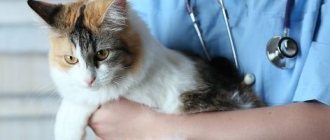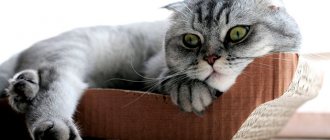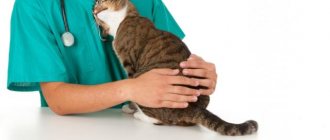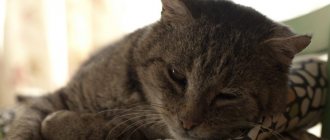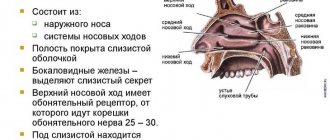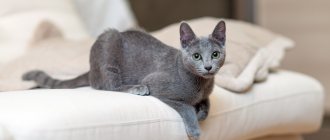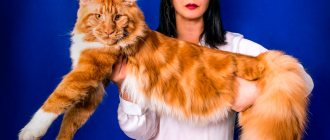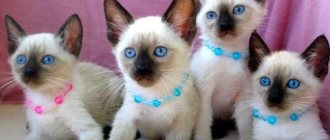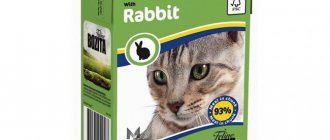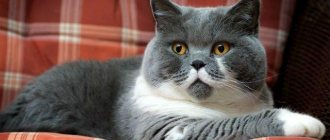Digestive system
The cat's digestive system consists of:
- esophagus;
- stomach;
- small intestine;
- duodenum;
- jejunum;
- liver;
- large intestine.
The esophagus has a hose-like shape of a relatively small size, and connects the animal’s mouth and its stomach. The esophagus originates from the inner base of the mouth, extends through the neck and chest, passes close to the heart, extends through the muscles of the diaphragm, and connects to the stomach. It is important to note that the esophagus is equipped with special muscles that push food into the stomach, producing synchronous movements similar to waves. The esophagus is one of the most difficult organs in terms of surgical treatment, as it is difficult to access and extremely difficult to heal.
The cat's stomach is single-chambered, and is distinguished by the location of the mucous membrane on its inner walls. The cat's stomach is adapted to accommodate a large amount of food, but it is almost never completely filled, since cats are not prone to gluttony (the vast majority). Also, the inner surface of the stomach is dotted with folds, which have an additional mechanical effect on the process of breaking down food. Food processed by gastric juice enters the duodenum through the pyloric sphincter. Most often, eaten food remains in the stomach for about 12 hours.
The small intestine is a tubular organ that connects the stomach and large intestine. Often the length of a cat's small intestine is about 1.5-2 meters, and includes the duodenum, jejunum, and ileum.
The duodenum is small in size and serves to mix food with liver and pancreatic enzymes, which is extremely important for digestion.
The jejunum is the longest part of the small intestine, and its internal walls are dotted with thin hairs, which, when in contact with food that comes into contact with them, penetrate into it and suck out all the useful substances. It is here that the final extraction of all useful substances from food occurs, after which it enters the ileum, and then the large intestine, where it turns into feces.
Features of the external structure of cats
On average, the length of an adult cat excluding the tail is 50-60 cm, with the tail - 75-85 cm. Sexual dimorphism is weak - females are only 5-7 cm smaller than males. The height of cats at the withers is 25-28 cm.
The largest cat, according to the Guinness Book of Records, is a Maine Coon from Melbourne named Omar, its length is 121.9 cm.
A pet weighs on average from 2.5 to 6.5 kg, but there are breeds whose representatives are considered real heavyweights. For example, the jungle cat, Siberian cat and Maine Coon can gain weight up to 13 kg.
Head
Cats have an elongated or rounded head. Relative to the entire body, it is small in size. For example, wild relatives like the tiger and lion have a larger muzzle due to a more massive jaw and pronounced fangs.
The surface pattern of a cat's nose is unique, like a human fingerprint.
The cat can rightfully be called a big-eyed animal. And it's not just a matter of keen eyesight. Cats are among the ten animals with the largest eye sizes relative to the size of their muzzle. Thanks to this feature, cats can immediately see a picture with a 200° field of view without moving their head (for comparison, a person’s visual range is only 180°).
Each cat’s ear is controlled by more than 10 muscles, thanks to which cats can change the position of the ears on the head - press them, bend them, turn them towards the sound, etc.
A special feature of the cat is the presence of very sensitive whiskers on its face. These are hard whiskers, which at the base are penetrated by a large number of nerve endings. Under no circumstances should you pull, let alone tear out, these whiskers - this causes pain to the animal.
With the help of whiskers, the cat receives information about everything that surrounds him - about objects, about the weather, approaching enemies and even the temperature of food
Torso
The body of a cat is divided into the back, chest, and abdomen. According to the relationship of the body to the head and paws, cats have three body types:
- Heavy - these cats have a wide body, a large head and rather short but dense legs and tail.
- Lungs - the body is slender and elongated, the head seems miniature in comparison.
- Medium - in this case, there is maximum harmony between the sizes of the body, head and tail. As a rule, outbred animals have an average body type.
Hair coat is of great importance for a cat. There are no wild naked cats (sphynxes are the result of artificial selection, they are not able to survive in nature). Wool protects the animal from cold, direct rays of the sun, and injuries. Miniature muscles located at the roots of the hairs can raise them on end - at such moments, cats seem larger than usual. This is a defense mechanism designed to scare off the enemy.
Cats love to climb higher - their long tail allows them to maintain balance.
Limbs
Some people mistakenly consider only the pads on which the animal steps when walking and running to be a cat's foot. In fact, it is longer and reaches a protuberance that is a vestigial finger (it can be easily felt, since the claw never retracts into it). It turns out that the cat moves “on tiptoe” all the time.
The photo shows that cats have five fingers - 4 on one side of the pad and one, rudimentary, located away from their “comrades”, on the opposite side
Circulatory system
The circulatory system in cats works the same way as in other mammals: the heart pushes blood through arteries that have elastic walls and rhythmically carry out contraction and relaxation movements. It is thanks to such movements that arteries located close to the skin can be felt, and this is called the pulse. The cat's pulse is easiest to detect on the inside of the thigh, and in a healthy animal it should range between 100-150 beats per minute.
The cat's brain absorbs 15-20% of the blood, the muscular system absorbs up to 40% of the total blood, and about 25-30% of the blood goes to the internal organs. During physical activity, muscles can absorb up to 90% of the blood, which is why cats get tired so quickly, but can focus maximum strength for a short period of time.
Cat's sense organs
Cats have well-developed senses. The following organs are responsible for the perception of the outside world in cats:
- Visual. Cat's eyes have a convex cornea, which makes it possible to obtain high-quality images. The pupils react to light by constriction. Cats see perfectly at a distance of 3–6 meters. In the dark, the eyes of these predators glow, which is explained by the presence of a tapetum - a special vascular layer located behind the retina. Color perception allows a cat to distinguish between 3 colors: blue, red and green.
- Auditory. Cat ears even perceive ultrasonic waves. The outer ear is a cartilaginous formation, it is very mobile due to its connection with 27 muscles. Cats have a fold of skin inside their ear.
- Olfactory. Cats have about 80 million olfactory receptors in their noses, which allow them to distinguish a huge number of odors.
- Tactile. The skin, mucous membranes, and vibrissae are responsible for the sense of touch. The sense of touch allows cats to determine the temperature of the environment, feel touch and experience pain.
- Flavoring. The receptors responsible for the perception of taste make cats excellent tasters. They sense and determine the quality of food well thanks to the Jacobson tubes located on the palate.
Sources:
https://prohvost.club/koshki/fiziologiya-koshek/skelet-koshki.html https://kot-pes.com/anatomiya-koshki/ https://murkoshka.ru/zdorovye/fiziologiya/opisanie-koshki.html
Endocrine system
The endocrine system is primarily responsible for hormones and their production in the corresponding organs. Thus, the cat’s brain produces antidiuretic hormone, oxytocin, corticotropic hormone, adrenocorticotropic hormone, cortisol and growth hormone.
The adrenal glands produce a lot of other hormones, the main purpose of which is to regulate metabolism, and are also responsible for behavioral characteristics. The adrenal glands also produce cortisol, a small portion of testosterone, as well as epinephrine and norepinephrine.
Stomach
A cat's stomach holds 300-400 ml and takes up about 70%
the entire capacity of the digestive tract, since the main chemical processing of protein foods occurs here. Gastric juice is a clear liquid with a free acidity of 40-60 TU (the same as in humans) and a hydrochloric acid content of 0.1-0.2%, pH = 1.0-2.1 (pronounced acidic environment). Hydrochloric acid neutralizes pathogenic microflora, helminth eggs and activates pepsinogens into pepsins and renin. Pepsins (A, B, C) are the first proteolytic enzymes involved in the hydrolysis of proteins to the stage of polypeptides (albumoses, peptones). Renin actively works in kittens and is necessary for the curdling of mother's milk. Gastric juice also contains lipase, but it has a weak hydrosizing effect on fats; its effect is mainly manifested on milk lipids. The epithelium of the stomach actively secretes mucins (stomach mucus) to protect the wall from the aggressive effects of hydrochloric acid and enzymes.
Nervous system
The nervous system of cats is divided into central and peripheral. Each of these systems in a cat performs functions that are standard for most mammals.
The central nervous system consists of the brain, brain stem and the so-called spinal cord. The central nervous system is the most important in the body of any living creature, and simple and complex reactions, as well as some reflexes, depend on it. In addition, the central nervous system interacts with the peripheral and autonomic ones, ensuring their functioning and control.
The peripheral nervous system is responsible for the cat's conscious motor abilities. So, thanks to this system, a cat can move its paws, extend its claws, run, and generally lead the lifestyle that it leads. Also, the peripheral nervous system transmits pain impulses to the central nervous system from any part of the body where peripheral nerve endings are present.
Leather and wool
The skin and coat protect the cat’s body from external influences: germs, overheating and hypothermia.
The cat's skin protects the body from harmful environmental influences
There are two main layers in a cat's skin:
- Epidermis is the top layer of skin.
- The dermis, inside which there are blood capillaries, hair follicles, nerve endings that transmit signals, as well as sebaceous glands that respond to nerve signals. Each hair follicle has its own sebaceous gland, which produces sebum, which gives the coat its shine. Special sebaceous glands are located in the anus and between the fingers; they produce pheromones. The sebaceous glands located on the face serve the cat to mark its territory.
Cat hair has special cells called cuticles. They reflect light, giving the coat a healthy shine. Therefore, dull fur on an animal always indicates problems in the body. The hair follicle has an erector muscle, which is capable of lifting the animal's fur, for example, in case of severe fear or hypothermia.
Cats' fur is raised by the erector muscle.
Cat hair has a tactile function. Whiskers located on the face, throat and front legs of cats are called whiskers. They are clearly visible on the animal's body. There are also small hairs - trilotiches, which are scattered on the surface of the animal's body.
Musculoskeletal system
The cat's body has two main types of muscles: smooth muscle and striated muscle. Smooth muscles are found in all the internal organs of the cat, and are directly connected to the autonomic nervous system, thereby ensuring the work and unconscious functioning of the internal organs, an excellent example of which would be the esophagus and the heart.
The striated muscles are attached to the skeleton and provide the cat with physical strength, the ability to move, hunt and fight. The striated muscles are familiar muscles that we can feel on the limbs and body of the pet.
An important part of the musculoskeletal system of a cat are tendons, ligaments and joints, which in all cats are distinguished by strength, flexibility and enviable elasticity until old age.
The cat's shoulder girdle, which has a unique structure, deserves special mention. Thus, in almost all mammals, the bones of the forelegs are connected to the body with the help of the collarbone, but in cats, the bones of the limbs are connected to the body exclusively with the help of muscles, which provides them with incredible mobility.
Oral cavity
The structural features of the digestive tube in a cat, like a predator, begin with the oral cavity. The shape of the teeth (incisors and fangs) ensures free tearing of large pieces of meat. There are no pronounced chewing surfaces on the molars, which indicates the absence of chewing of the food bolus. Indeed, if you pay attention to how a cat eats prey in natural conditions - it tears it off, bites it, crushes it, crushes the pieces and swallows. Cat saliva has a slightly alkaline environment, moistens the food bolus so that it moves further more easily, and due to mucin it provides a protective function against pathogenic bacteria. Considering that a cat is an obligate carnivore, the content of amylase (an enzyme that breaks down carbohydrates) in saliva is low. Next, the food bolus moves through the esophagus. The esophagus of predators has striated muscles, so cats are able to spontaneously induce vomiting.
Animal spine
In the structure of a cat's skeleton, the longest element is the spine. It has incredible flexibility, which is due to the presence of tiny movable bones. This part of the cat's skeleton is formed from many vertebrae, divided into sections such as cervical, thoracic, lumbar, sacral and caudal. Each of them has certain characteristics and deserves special attention.
It is noteworthy that the tail is considered an integral part of the cat's spine. This organ is responsible for maintaining the animal’s balance during jumps and falls.
Cervical region
This section is formed by the larger 7 vertebrae, which are responsible for the support and mobility of the animal’s head. Two of them, called epistropheus (axial, axis) and atlas, are endowed with the unique ability to rotate 180 degrees. These vertebrae are connected to each other by a thin finger-like process.
Due to the increased fragility of such a connecting element, the epistrophy and atlas are considered the most vulnerable parts of the cat’s body, since when injured (impacts, falls from a great height), there is a high probability of damage to the process connecting them, which leads to a fracture of the cervical vertebrae and the death of the animal.
It is for this reason that experts do not recommend using a belt in this part of the cat’s body. Despite its flexibility, the cat's skeleton consists of several extremely fragile elements, which in some cases can be damaged. Under normal conditions, the animal's neck is completely safe. Unlike a belt, a flea collar is completely safe for such a pet.
Chest and ribs
This section of the cat's spine includes 13 vertebrae. 24 rib bones are attached to them on both sides. The first 5 pairs of ribs are called true, because they are attached to the sternum. The remaining ribs, which have an arched shape, are usually called false (false). Thanks to this structure of the rib bones, the flexibility of the animal’s body and its ability to turn around even in conditions of very limited space are ensured.
Lumbar and sacral regions
The lumbar spine of a cat includes the 7 largest vertebrae. As they approach the tail, their size increases. These elements have special protrusions on the sides. They are designed to attach the muscles and internal organs of the abdominal cavity. A high degree of mobility of this section is achieved due to the fact that elastic cartilage pads are attached to its vertebrae.
Unlike the flexible lumbar, the sacral region is formed from 3 fused vertebrae, between which there is a rigid intervertebral joint. This feature is due to the fact that the cat’s hind legs are attached to this area, which bear the main load during its movement, especially during jumping.
Caudal vertebrae
The caudal spine of the cat's skeleton plays one of the main roles in maintaining the animal's balance during jumps and falls from heights. The ideal jumping ability of cats is ensured by strong muscle ligaments, and the ability to unhindered complex movements (bending and rotation) is ensured by intervertebral cartilaginous pads.
The number of vertebrae in this section directly depends on the characteristics of the breed of representatives of the cat family. There are cat breeds that do not have them at all. On average, the average animal has about 20–25 caudal vertebrae. The tail is a kind of steering device for a cat. It helps him balance while walking and falling. This explains the fact that most short-tailed or tailless representatives of this family are more clumsy compared to their counterparts with a full tail.
This does not limit the function of this body. It not only helps the cat balance, but also serves as a kind of litmus test for its mood. If an animal furiously beats its tail on the floor or vigorously waves it from side to side, it means that it is in an irritated or aggressive state and it is better not to approach it.
If your pet tucks its tail to its hind legs, it is most likely that it is very frightened by something and should be calmed down.
Limbs
The upper regions that make up the skeleton were discussed above. A cat's front paws are different from their back paws. As mentioned above, it moves on the fingers. The heel is visible on the hind legs. It may look like it's a knee. But it is located at the level of the lower abdomen. There are five fingers on the forelimbs. At the same time, the fifth one is greatly shortened and does not touch the surface while walking. The last phalanx in each finger acts as a base for the claw. It is pulled into the pad using a special ligament. It is missing only on the first finger. It acts as a rudiment and grows separately. The claw on it does not retract. The hind limbs, unlike the forelimbs, are quite rigidly attached to the sacrum. The bones in this part are more developed and longer. The hind legs have 4 toes. Here the fifth digit, which is present on the forelimbs, is presented as a skin protrusion. The weight of the animal's body is distributed evenly over the entire foot of the hind paw. Like other mammals, the knees bend forward and the elbows bend backward. A distinctive feature of the forelimbs is also the rotating wrists.
Cat muscle structure
Step 1
Muscles give the body its shape. You can draw the body without knowing the muscle structure, but guessing is not the best way. You might think that this is too difficult, but I will show you that it is not that difficult.
First cover the skeleton with simplified muscle mass. Yes, it's that simple! If you're drawing a very fluffy cat, this is all you need. The muscles will not be visible in any case.
Step 3
Those of us who prefer short-haired or medium-length cats need to learn a little more. They can still be simplified. These are large muscle masses visible under the skin. If you want to learn them painlessly, use this sample to get started. After a few exercises, this structure will be remembered.
Step 5
There is something else. Cats have fairly loose skin; in some places it does not hide the muscles. If you have a cat, try touching the area between the thigh and the back of the shin - you will only feel the skin and fur! This extra skin prevents you from seeing the thigh or back of the lower leg when the cat is sitting.
Video: How Cats See. What do cats see? Why does Cat's Eye burn in the dark?
As for brain volume, scientists have proven that the brain size of a thin forest cat is much larger than that of a well-fed domestic British cat. This fact is explained by the fact that brain volume is directly dependent on the animal’s mobility and the complexity of the musculoskeletal functions performed by the cat throughout its life.
But it cannot be said that a domestic cat’s brain is not developed or that it is stupid. Quite the contrary, any cat, be it a wild street cat or a spoiled domestic beauty, has a fairly well-developed brain, with its help the cat is able to make decisions and compare almost with lightning speed.
You can also note the cat’s ability to move quickly, quickly and silently. Such skills are easily explained by the fact that the cat has a very unusual type of walking; it first moves its left paws, and then its right ones. Only cats, camels and giraffes are endowed with such an unusual gait.
Unlike all other animals and humans, cats have a different number of toes on their paws: there are four on the hind paws and five on the front paws. A large quarter of cats have the ability to use both their right and left paws equally. This gait gives the impression that the cat is walking on tiptoe. But that's not true. The cat's body weight is evenly distributed over the entire foot, but the cat still walks quietly and silently.
Everyone has probably noticed that cats have no smell. This is due to the fact that cats do not have sweat and fat glands on their bodies, except for the delicate pads on their paws. Very often, cat owners notice that after being examined by a veterinarian, wet marks from small cat paws remain on the table; this is sweat discharge. This biological feature causes cats a lot of trouble in the heat, so hot and dry weather, especially for British cats, is not the most pleasant time.
A cat is one of those animals on which nature has worked especially carefully. Few animals can boast such physical capabilities as a cat. Developing from a small kitten to an adult, a cat brings all its movements to automatism, these include acrobatic elements, fast running, incredible high and long jumps, climbing and crawling, instant coordination of all its movements, as well as instant reaction.
It is also necessary to pay special attention to the cat’s skeleton. It consists of 240 individual bones and 500 muscles. A cat's tail consists of 26 vertebrae
Most of the bones are connected to each other by cartilage tissue, and the remaining bones are connected by joints. And thanks to the veins, the cat can release or hide sharp claws in leather pouches that are located between the toes.
A cat's tail consists of 26 vertebrae. Most of the bones are connected to each other by cartilage tissue, and the remaining bones are connected by joints. And thanks to the veins, the cat can release or hide sharp claws in leather pouches that are located between the toes.
A cat's skin is covered with a dense network of muscles and blood vessels, which explains the fact that the cat is very sensitive to temperature changes and any touch. Also, cat skin is completely covered with a dense layer of hair.
